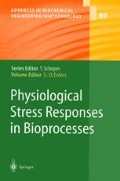Abstract
In order to survive under and adapt to different conditions Escherichia coli has evolved elaborate systems that are able to sense and respond to environmental stimuli. Very often, different stresses act on a bacterium simultaneously and a variety of stresses have similar effects on cellular molecules and processes. Therefore, the various stress response systems have to interact (cross talk) with each other. A complex network of global regulatory systems with a multitude of molecular components ensures a coordinated and effective answer. Such regulatory components include DNA, mRNAs, sRNAs, proteins, such as DNA-and RNA binding proteins, alternative sigma factors and two-component systems, as well as small molecular weight molecules, as for example (p)ppGpp. These regulatory systems govern the expression of a plethora of further effectors that aim at maintaining stability of the cellular equilibrium under the various conditions. Using five of the most important stress response systems, we will discuss the roles and mechanisms of such regulatory and effector molecules in more detail. The heat shock response, controlled by the sigma factor σ32, and the envelope stress response, controlled by the sigma factor σE and the Cpx two-component system, both result in an increased expression of chaperones and proteases in response to misfolded proteins. The cold shock response governs expression of RNA chaperones and ribosomal factors, ensuring accurate translation at low temperatures. The general stress response depends on the sigma factor σS, which controls the expression of more than 50 genes conferring resistance to many different stresses. The (p)ppGpp-dependent stringent response reduces the cellular protein synthesis capacity and controls further global responses upon nutritional downshift.
A lot has been learned in recent years about the mechanisms of action of single components. However, the main challenge for the future is to achieve an understanding of the interactions of these components under different physiological conditions.

Preview
Unable to display preview. Download preview PDF.
Author information
Authors and Affiliations
Corresponding author
Rights and permissions
About this chapter
Cite this chapter
Wick, L.M., Egli, T. Molecular Components of Physiological Stress Responses in Escherichia coli . In: Physiological Stress Responses in Bioprocesses. Advances in Biochemical Engineering, vol 89. Springer, Berlin, Heidelberg. https://doi.org/10.1007/b93957
Download citation
DOI: https://doi.org/10.1007/b93957
Published:
Publisher Name: Springer, Berlin, Heidelberg
Print ISBN: 978-3-540-20311-7
Online ISBN: 978-3-540-39669-7
eBook Packages: Springer Book Archive

